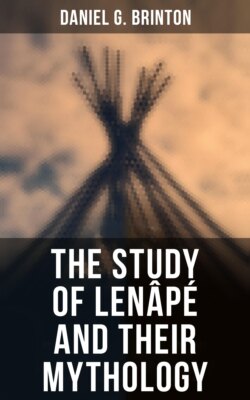Читать книгу The Study of Lenâpé and Their Mythology - Daniel G. Brinton - Страница 14
На сайте Литреса книга снята с продажи.
The Nanticokes.
ОглавлениеTable of Contents
The Nanticokes occupied the territory between Chesapeake Bay and the ocean, except its southern extremity, which appears to have been under the control of the Powhatan tribe of Virginia.
The derivation of Nanticoke is from the Delaware Unéchtgo, "tide-water people," and is merely another form of Unalachtgo, the name of one of the Lenape sub-tribes. In both cases it is a mere geographical term, and not a national eponym.
In the records of the treaty at Fort Johnston, 1757, the Nanticokes are also named Tiawco. This is their Mohegan name, Otayãchgo, which means "bridge people," or bridge makers, the reference being to the skill with which the Nanticokes could fasten floating logs together to construct a bridge across a stream. In the Delaware dialect this was Tawachguáno, from taiachquoan, a bridge. The latter enables us to identify the Tockwhoghs, whom Captain John Smith met on the Chesapeake, in 1608, with the Nanticokes. The Kuscarawocks, whom he also visited, have been conclusively shown by Mr. Bozman[23] to have been also Nanticokes.
By ancient traditions, they looked up to the Lenape as their "grandfather," and considered the Mohegans their "brethren."[24] That is, they were, as occasion required, attached to the same confederacy.
In manners and customs they differed little from their northern relatives. The only peculiarity in this respect which is noted of them was the extravagant consideration they bestowed on the bones of the dead. The corpse was buried for some months, then exhumed and the bones carefully cleaned and placed in an ossuary called man-to-kump (= manito, with the locative termination, place of the mystery or spirit).
When they removed from one place to another these bones were carried with them. Even those who migrated to northern Pennsylvania, about the middle of the last century, piously brought along these venerable relics, and finally interred them near the present site of Towanda, whence its name, Tawundeunk, "where we bury our dead."[25]
Their dialect varied considerably from the Delaware; of which it is clearly a deteriorated form. It is characterized by abbreviated words and strongly expirated accents, as tah! quah! quak! su, short; quah! nah! qut, long.
Our knowledge of it is limited to a few vocabularies. The earliest was taken down by Captain John Smith, during his exploration of the Chesapeake. The most valuable is one obtained by Mr. William Vans Murray, in 1792, from the remnant in Maryland. It is in the library of the American Philosophical Society, and has never been correctly or completely printed.
The Nanticokes broke up early. Between the steady encroachments of the whites and the attacks of the Iroquois they found themselves between the upper and the nether millstones.
According to their own statement to Governor Evans, at a conference in 1707, they had at that time been tributary to the latter for twenty-seven years, i.e., since 1680. Their last head chief, or "crowned king," Winicaco, died about 1720. A few years after this occurrence bands of them began to remove to Pennsylvania, and at the middle of the century were living at the mouth of the Juniata, under the immediate control of the Iroquois. Thence they removed to Wyoming, and in 1753, "in a fleet of twenty-five canoes," to the Iroquois lands in western New York. Others of their nation were brought there by the Iroquois in 1767; but by the close of the century only five families survived in that region.[26]
A small band called the Wiwash remained on Goose creek, Dorchester county, Maryland, to the same date.
